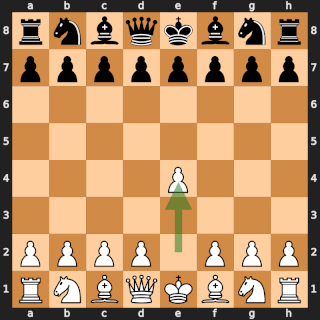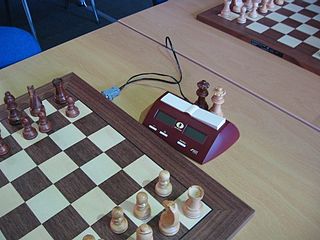
Chess is a board game for two players, called White and Black, each controlling an army of chess pieces in their color, with the objective to checkmate the opponent's king. It is sometimes called international chess or Western chess to distinguish it from related games, such as xiangqi and shogi. The recorded history of chess goes back at least to the emergence of a similar game, chaturanga, in seventh-century India. The rules of chess as we know them today emerged in Europe at the end of the 15th century, with standardization and universal acceptance by the end of the 19th century. Today, chess is one of the world's most popular games, played by millions of people worldwide.

The queen is the most powerful piece in the game of chess. It can move any number of squares vertically, horizontally or diagonally, combining the powers of the rook and bishop. Each player starts the game with one queen, placed in the middle of the first rank next to the king. Because the queen is the strongest piece, a pawn is promoted to a queen in the vast majority of cases.
This glossary of chess explains commonly used terms in chess, in alphabetical order. Some of these terms have their own pages, like fork and pin. For a list of unorthodox chess pieces, see Fairy chess piece; for a list of terms specific to chess problems, see Glossary of chess problems; for a list of named opening lines, see List of chess openings; for a list of chess-related games, see List of chess variants; for a list of terms general to board games, see Glossary of board games.
Zugzwang is a situation found in chess and other turn-based games wherein one player is put at a disadvantage because of their obligation to make a move; a player is said to be "in zugzwang" when any legal move will worsen their position.
This glossary of chess problems explains commonly used terms in chess problems, in alphabetical order. For a list of unorthodox pieces used in chess problems, see Fairy chess piece; for a list of terms used in chess is general, see Glossary of chess; for a list of chess-related games, see List of chess variants.
The fifty-move rule in chess states that a player can claim a draw if no capture has been made and no pawn has been moved in the last fifty moves. The purpose of this rule is to prevent a player with no chance of winning from obstinately continuing to play indefinitely or seeking to win by tiring the opponent.

The Immortal Game was a game of chess, played in 1851 by Adolf Anderssen and Lionel Kieseritzky. It was played while the London 1851 chess tournament was in progress, an event in which both players participated. However, the Immortal Game was itself a casual game, not played as part of the tournament. Anderssen won the game by allowing a double rook sacrifice, a major loss of material, while also developing a mating attack with his remaining minor pieces. Despite losing the game, Kieseritzky was impressed with Anderssen's performance. Shortly after it was played, Kieseritzky published the game in La Régence, a French chess journal which he helped to edit. In 1855, Ernst Falkbeer published an analysis of the game, describing it for the first time with its namesake "immortal".

The Opera Game was an 1858 chess game, played at an opera house in Paris. The American master Paul Morphy played against two strong amateurs: the German noble Karl II, Duke of Brunswick, and the French aristocrat Comte Isouard de Vauvenargues. It was played as a consultation game, with Duke Karl and Count Isouard jointly deciding each move for the black pieces, while Morphy controlled the white pieces by himself. The game was played in a box while an opera was performed on stage. Morphy quickly checkmated his opponents following rapid development of material, involving a queen sacrifice.

Checkmate is any game position in chess and other chess-like games in which a player's king is in check and there is no possible escape. Checkmating the opponent wins the game.
In chess and other related games, a double check is a check delivered by two pieces simultaneously. In chess notation, it is almost always represented the same way as a single check ("+"), but is sometimes symbolized by "++". This article uses "++" for double check and "#" for checkmate.
In chess, a pure mate is a checkmate position such that the mated king is attacked exactly once, and prevented from moving to any of the adjacent squares in its field for exactly one reason per square. Each of the squares in the mated king's field is attacked or "guarded" by one—and only one—attacking unit, or else a square which is not attacked is occupied by a friendly unit, a unit of the same color as the mated king. Some authors allow that special situations involving double check or pins may also be considered as pure mate.
Handicaps in chess are handicapping variants which enable a weaker player to have a chance of winning against a stronger one. There are a variety of such handicaps, such as material odds, extra moves, extra time on the chess clock, and special conditions. Various permutations of these, such as "pawn and two moves", are also possible.

In chess, promotion is the replacement of a pawn with a new piece when the pawn is moved to its last rank. The player replaces the pawn immediately with a queen, rook, bishop, or knight of the same color. The new piece does not have to be a previously captured piece. Promotion is mandatory; the pawn cannot remain as a pawn.
In chess, a queen sacrifice is a move that sacrifices a queen in return for some compensation, such as a tactical or positional advantage.
In chess, a flight square or escape square is a safe square to which a piece, especially a king, can move if it is threatened.
A pawnless chess endgame is a chess endgame in which only a few pieces remain, and no pawns. The basic checkmates are types of pawnless endgames. Endgames without pawns do not occur very often in practice except for the basic checkmates of king and queen versus king, king and rook versus king, and queen versus rook. Other cases that occur occasionally are (1) a rook and minor piece versus a rook and (2) a rook versus a minor piece, especially if the minor piece is a bishop.
In chess, an ideal mate is a checkmate position that is a special form of model mate. While in a model mate, each piece on the mating player's side participates in the mate, an ideal mate involves all the pieces of the mated player's as well, typically by blocking the mated king's field of movement so that it cannot escape. As in a model mate, an ideal mate also involves the mating pieces attacking the vacant squares around the mated king's exactly once, and not attacking the mated player's other pieces occupying the king's field of movement.

In chess, several checkmate patterns occur frequently enough to have acquired specific names in chess commentary. By definition, a checkmate pattern is a recognizable/particular/studied arrangements of pieces that delivers checkmate. The diagrams that follow show these checkmates with White checkmating Black.

The following outline is provided as an overview of and topical guide to chess:







